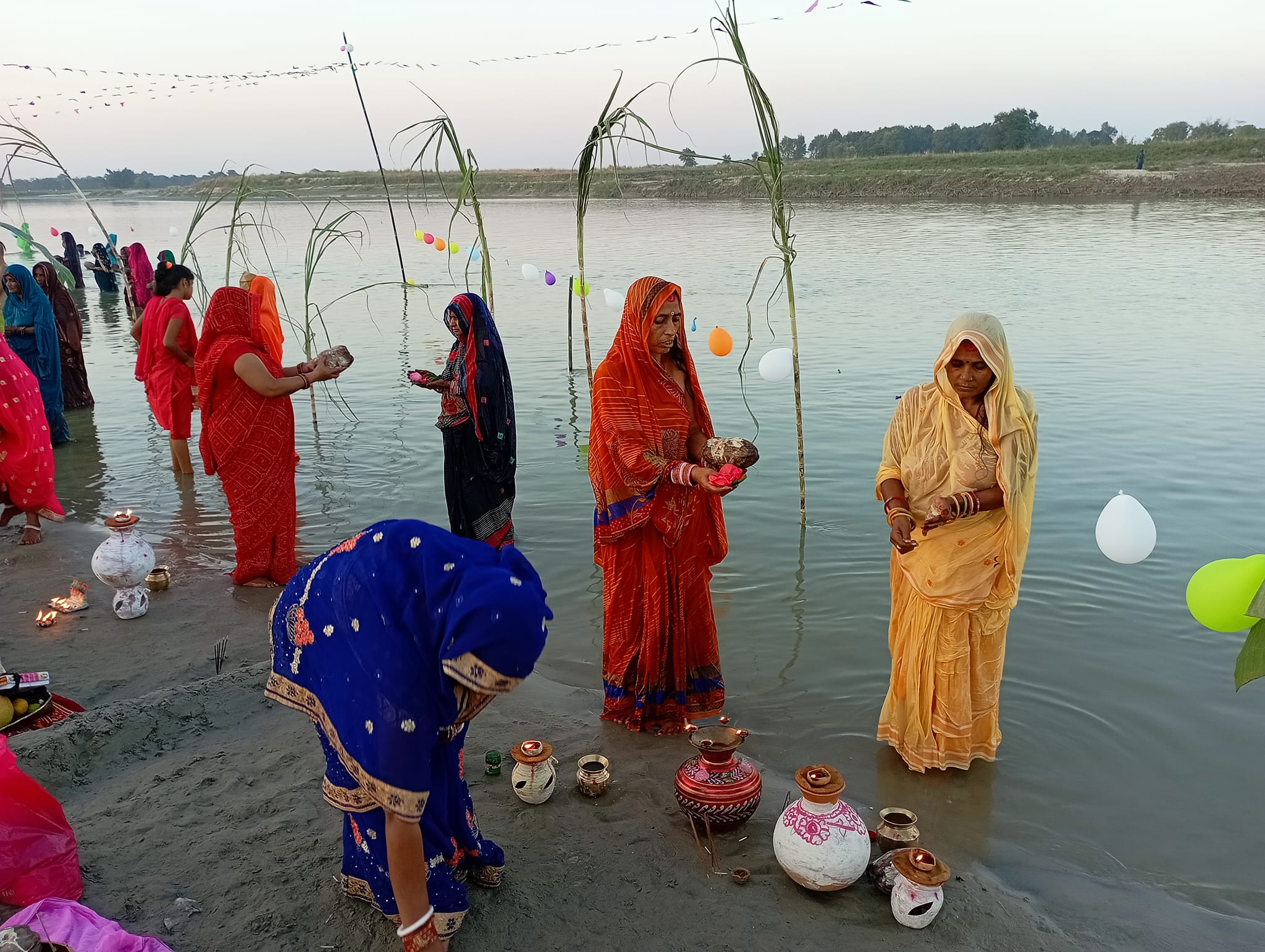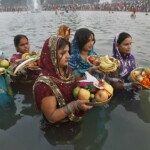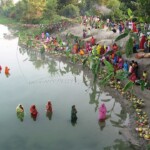
Chhath Puja, one of the most significant festivals in Hindu culture, is a 4-day celebration dedicated to the worship of the Sun God, Lord Surya. It is observed with great devotion and enthusiasm, primarily in the states of Bihar, Jharkhand, Uttar Pradesh, and certain regions of Nepal. In this article, we will explore the history, significance, and rituals of Chhath Puja, as well as the anticipation surrounding the Chhath Puja celebrations in 2024.
History of Chhath Puja
Chhath Puja, an ancient Hindu festival, has a rich and fascinating history that dates back to the Vedic period. The origins of this significant celebration can be traced to the epic Ramayana, which plays a pivotal role in the legend associated with Chhath Puja.
According to Hindu mythology, Sita, the beloved wife of Lord Rama, was kidnapped by the demon king Ravana and held captive in Lanka. After Rama’s victorious battle to rescue Sita and his return to Ayodhya, Sita observed a rigorous fast and performed various rituals in honour of the Sun God, Lord Surya, to seek his blessings and gratitude for her safe return.
Sita’s devotion and determination during her fast deeply impressed Lord Rama and the sages, who acknowledged her unwavering faith and love for Lord Surya. As a result, Chhath Puja became a significant festival and was declared a grand annual event to celebrate the reverence for the Sun God and Sita’s devotion.
Another legend linked to Chhath Puja is associated with the Mahabharata. It is believed that the Pandavas, the protagonists of the epic, also observed Chhath Puja regain their lost kingdom after completing their exile. Their devotion and rituals impressed Lord Surya, who bestowed his blessings upon them, aiding in their triumph over adversity.
Over the centuries, Chhath Puja evolved and gained prominence in the regions of Bihar, Jharkhand, Uttar Pradesh, and certain parts of Nepal, where it became an integral part of the cultural fabric. Today, the festival has expanded its reach beyond these regions, attracting devotees from various corners of the world.
Throughout history, Chhath Puja has remained a symbol of gratitude, purity, and self-discipline. The festival’s rituals, fasting, and offerings to the Sun God continue to exemplify the unwavering devotion and spiritual connection between human beings and nature. As the years pass, Chhath Puja stands as a timeless tradition, preserving its historical significance while embracing the essence of togetherness and reverence for the celestial body that sustains life – the Sun.
Images of Chhath Puja
The Origins of Chhath Puja
Chhath Puja has its origins in ancient Hindu scriptures and is believed to date back to the Vedic period. The word “Chhath” refers to the number six, as the festival is celebrated on the sixth day of the Hindu lunar month of Kartik, which usually falls in October or November.
According to Hindu mythology, Chhath Puja was first observed by Sita, the wife of Lord Rama, after returning to Ayodhya from captivity. She performed rigorous rituals and fasted to seek the blessings of Lord Surya for the well-being and prosperity of her family. Since then, Chhath Puja has been celebrated as a symbol of gratitude and reverence to the Sun God.
Kartika Chhath Puja Date 2024
| Date | Day | Event | Hindi Tithi |
| 05-November-2024 | Tuesday | Nahay Khay | Chaturthi |
| 06-November-2024 | Wednesday | Lohanda and Kharna | Panchami |
| 07-November-2024 | Thursday | Sandhya Arghya | Shashthi |
| 08-November-2024 | Friday | Usha Arghya, Parana Day | Saptami |
Understanding the Significance of Chhath Puja
Chhath Puja holds immense spiritual and cultural significance. The festival is not merely a religious ritual but also an expression of the profound connection between humans and nature. Lord Surya, the Sun God, is considered the source of life, energy, and vitality. By worshipping the Sun, devotees seek blessings for a healthy and prosperous life.
Chhath Puja also symbolizes purity and self-discipline. The four-day fasting and various rituals during the festival signify the devotees’ dedication and determination to maintain purity in thoughts, actions, and deeds.
The 4-Day Celebration of Chhath Puja
Chhath Puja is a four-day-long festival, with each day marked by specific rituals and observances. Let’s delve into the significance of each day:
Day 1: Nahay Khay
The first day of Chhath Puja is known as Nahay Khay, which translates to “bathing and eating.” Devotees take a dip in a sacred river or pond before sunrise, symbolizing purification of the body and soul. After the holy bath, they prepare a vegetarian meal and offer it to the Sun God before breaking their fast.
Day 2: Lohanda and Kharna

The second day, known as Lohanda and Kharna, is when devotees observe a strict fast without water throughout the day. In the evening, after sunset, they perform Kharna, where they break their fast by consuming a special Prasad, usually made of kheer (rice pudding) and fruits.
Day 3: Sandhya Arghya (Offering in the evening)

Sandhya Arghya, the third day of Chhath Puja, is the most important day of the festival. Devotees gather on the banks of rivers or other water bodies in the evening to offer their prayers to the setting Sun. They make offerings of fruits, sugarcane stalks, and thekua (a traditional sweet) to express their gratitude to Lord Surya.
Day 4: Usha Arghya (Morning Offering)

The final day of Chhath Puja is known as Usha Arghya. Devotees wake up before sunrise to offer their prayers to the rising Sun. They perform the same rituals as on the previous day, bidding farewell to Lord Surya and seeking his blessings.
Chhath Puja Preparations and Rituals
The preparations for Chhath Puja begin well in advance. Devotees clean their homes, wear new clothes, and decorate their surroundings with colorful rangolis and diyas (lamps). Special prayer items and offerings are purchased, and families come together to prepare the Prasad and other delicacies.
During Chhath Puja, devotees observe strict discipline and purity. They abstain from non-vegetarian food, onion, and garlic during the festival. The act of fasting is not only a test of devotion but also an opportunity for self-purification and spiritual introspection.
The Spiritual Connection with the Sun God
Chhath Puja fosters a deep spiritual connection between human beings and the Sun God, Lord Surya. The Sun is considered a divine deity in Hinduism, representing life, knowledge, and enlightenment. Worshipping the Sun is believed to bestow wisdom, vitality, and prosperity upon devotees.
The act of offering prayers and making offerings to the Sun during Chhath Puja is seen as a way to express gratitude for the life-sustaining energy provided by the Sun. It is also a reminder of the interconnectedness of all living beings with nature.
Chhath Puja Vidhi
Mantra
ॐ सूर्य देवं नमस्ते स्तु गृहाणं करूणा करं |
अर्घ्यं च फ़लं संयुक्त गन्ध माल्याक्षतै युतम् ||
Chhath Puja Vidhi, also known as the Chhath Puja procedure or rituals, is a series of sacred practices and customs that devotees follow during the four-day celebration. Each day of Chhath Puja has specific rituals, and adhering to the prescribed Vidhi is considered essential to seek the blessings of the Sun God, Lord Surya, and ensure the fulfilment of wishes. Let’s explore the Chhath Puja Vidhi step by step:
Day 1: Nahay Khay
- Holy Dip: On the first day, devotees wake up early before sunrise and take a sacred dip in a nearby river, pond, or any water body. The holy bath is a symbolic act of purification of the mind, body, and soul.
- Preparing Prasad: After the holy dip, devotees prepare a pure vegetarian meal, which usually includes rice, dal, and pumpkin vegetables. The meal is cooked without salt and onion-garlic, emphasizing the need for self-discipline during the fasting period.
- Offering to the Sun: Before breaking their fast, devotees offer the prepared Prasad to the Sun God. Facing the rising Sun, they seek his blessings and express gratitude for life, energy, and vitality.
Day 2: Lohanda and Kharna
- Fasting without Water: On the second day, devotees observe a strict fast without water throughout the day. This period of fasting is known as Lohanda.
- Evening Offering: In the evening, after sunset, devotees break their fast by performing Kharna. They consume the Prasad prepared with rice pudding (kheer) and fruits, which are offered to the Sun God during the evening.
Day 3: Sandhya Arghya
- Ritual Bath: On the third day, devotees again take a holy dip in the water body during the evening, facing the setting Sun. This ritual bath is called Sandhya Arghya.
- Offerings to the Sun: After the ritual bath, devotees make offerings to the setting Sun. They present fruits, sugarcane stalks, and traditional sweets like thekua to express their gratitude and seek blessings.
Day 4: Usha Arghya
- Pre-Dawn Preparations: The fourth day, also known as Usha Arghya, starts with devotees waking up before sunrise to prepare for the final day of Chhath Puja.
- Offering at Sunrise: Devotees once again offer prayers to the rising Sun, making offerings of fruits, sweets, and other Prasad items.
- Breaking the Fast: After completing the morning rituals, devotees break their four-day long fast. They partake in the Prasad and celebrate the successful completion of Chhath Puja.
Chhath Puja Celebrations Across the Globe
Over the years, Chhath Puja has transcended geographical boundaries and gained recognition beyond the Indian subcontinent. With the Indian diaspora settling in various parts of the world, Chhath Puja is now celebrated with great fervour in countries like the United States, the United Kingdom, Canada, Australia, and more.
The celebration of Chhath Puja in these regions not only strengthens cultural bonds but also promotes the rich heritage of Hindu traditions. It serves as an opportunity for people from different backgrounds to come together and celebrate the spirit of togetherness and gratitude.
Capturing the Essence of Chhath Puja in Art and Photography
Chhath Puja provides a picturesque setting that captures the imagination of artists, photographers, and filmmakers alike. The vibrant rituals, the devotion of the devotees, and the scenic beauty of water bodies during the festival offer ample opportunities for artistic expression.
Artists often depict the beauty of Chhath Puja through paintings, while photographers capture the emotions and rituals through their lenses. These artistic representations not only preserve the essence of the festival but also showcase its cultural significance to a global audience.
Safety Measures During Chhath Puja
With large gatherings and celebrations, safety becomes a crucial aspect of Chhath Puja. Local authorities and community organizers must take necessary precautions to ensure the well-being of the devotees.
Proper crowd management, provision of clean drinking water, medical facilities, and security arrangements are essential to prevent any untoward incidents. Additionally, raising awareness about eco-friendly celebrations and avoiding plastic waste can contribute to a cleaner and greener Chhath Puja.
Chhath Puja 2024: What to Expect
As Chhath Puja approaches in 2024, excitement and anticipation fill the air. Devotees eagerly look forward to the grand celebrations, reuniting with friends and family, and renewing their bond with Lord Surya.
The year 2024brings the promise of hope and optimism, and Chhath Puja will be celebrated with even greater enthusiasm after the challenges faced in the preceding years. The festive spirit will engulf the regions where Chhath Puja is celebrated, and the atmosphere will be one of joy, devotion, and togetherness.
Joining the Joyous Chhath Puja Celebrations
For those interested in experiencing the magic of Chhath Puja, joining the celebrations in regions where the festival is widely observed can be a memorable experience. Witnessing the devotion and rituals firsthand and being part of the community celebrations can leave a lasting impression of unity and spirituality.
Conclusion
Chhath Puja is a festival that transcends religious boundaries and celebrates the spirit of gratitude, purity, and togetherness. As devotees prepare for Chhath Puja 2024, they eagerly await the opportunity to connect with the Sun God and seek his blessings. The four-day celebration, filled with fasting, rituals, and festivities, brings communities together and reinforces the importance of cherishing our cultural heritage and preserving the environment.
Chhath Puja FAQs
When does Chhath Puja take place?
Chhath Puja is observed on the sixth day of the Hindu lunar month of Kartik, which typically falls in October or November.
Why is Chhath Puja significant?
Chhath Puja is significant as it symbolizes the spiritual connection with nature, the purification of the mind and body through fasting, and the celebration of togetherness within communities.
Where is Chhath Puja celebrated?
Chhath Puja is primarily celebrated in the states of Bihar, Jharkhand, Uttar Pradesh, and certain regions of Nepal. However, its popularity has spread to various countries with the Indian diaspora, such as the United States, the United Kingdom, Canada, and Australia.
How can I participate in Chhath Puja celebrations?
If you wish to participate in Chhath Puja celebrations, you can visit regions where the festival is widely observed and engage in rituals and prayers with the local community.
Kartika Chhath Puja Date 2023
| Date | Day | Event | Hindi Tithi |
| 17-Nov-23 | Friday | Nahay Khay | Chaturthi |
| 18-Nov-23 | Saturday | Lohanda and Kharna | Panchami |
| 19-Nov-23 | Sunday | Sandhya Arghya | Shashthi |
| 20-Nov-23 | Monday | Usha Arghya, Parana Day | Saptami |











